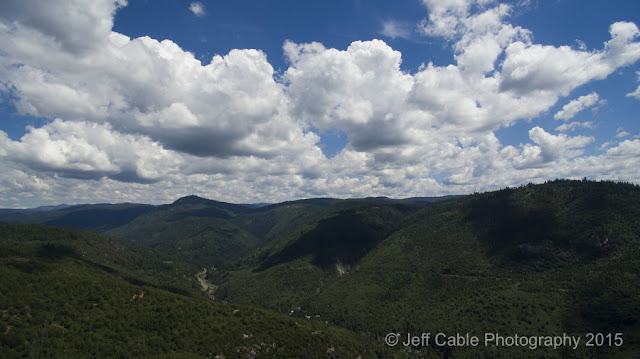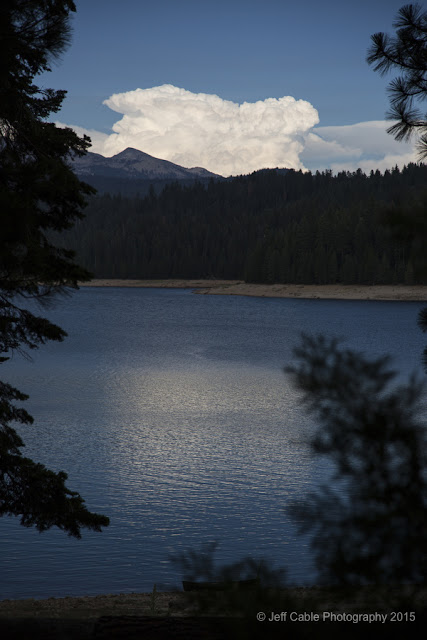When I got back to my hotel room and downloaded the images, I started to make notes of how to properly photograph waterfalls. I took a break and went downstairs to get some dinner, and while at the table (where they do not allow any electronics - so no distractions) I thought that the information should be shared with all of you, not just the people coming tomorrow.
So...here you go. A blog post explaining the best techniques for photographing waterfalls.
Gear
First, lets talk about the equipment that you need. Beside having a camera and lens, you really should have a good tripod and a polarizing filter. The tripod holds the camera perfectly still so that you can shoot at slow shutter speeds (which we will talk about in a moment). The polarizing filter lets you cut the glare off the tops of the still water and the wet rocks surrounding the waterfall. The filter also blocks some of the light, which is helpful. I relied on my Canon 1Dx, 24-105mm lens, Gitzo travel tripod and the Tiffen Circular Polarizing filter for all of today's photos.
Optimal weather
Believe it or not, I prefer to have overcast skies when shooting waterfalls and streams. This gives me nice even light across the frame, without the splotches of sunlight coming through the surrounding trees. The other advantage of overcast skies is that it is usually darker outside. This, along with the polarizing filter, makes it easier to get a nice slow shutter speed.
Slow shutter speeds
Freezing action in sports is great, but freeing water coming off of a waterfall is not ideal. The photo below was taken at 1/500th of a second and shows the water as we see it in person.
I prefer to slow down the shutter speed to create a milky smooth flow of water. Depending on the speed of the flowing water, I usually shoot between half a second and 2 seconds to get a nice flow.
This second image, taken in the exact same spot as the first photo, was taken with a shutter speed of 1.7 seconds. When you are shooting, I would recommend that you try different shutter speeds to see which yields the look that you want.
For those of you wondering how to slow your shutter speed, I would recommend the following. Set your ISO to 100 and then you can try shooting in shutter priority mode at the desired speed or aperture priority at a very small aperture (maybe something like f/22).
Isolate
Most people who take photos of waterfalls, do so with the entire waterfall in the photo. Sometimes it is more interesting to isolate a portion of the fall. Try zooming in with your lens to find interesting scenes within the larger picture.
I saw the water dripping straight off of the rock in the foreground and thought that this would make for an interesting shot.
Look around
OK, this may not be about shooting waterfalls, but I wanted to remind you all to look around when you are taking photos. Don't get so consumed with a subject that you miss other interesting photo opportunities.
I was walking from one area of the river to another and spotted these flowers reflecting in the still water. It is not the intensity of a waterfall, but it is definitely worth a shot.
Include foreground and backgrounds
There is nothing more boring to me than a straight-on photo of a waterfall, especially if it taken at a fast shutter speed. Heck, anyone can take that photo, and many do. You should strive to include the surroundings. Look for a scene which compliments the water fall and adds interest to the overall photo. Don't be afraid to move around (as long as it is safe) to get a pleasing angle.
I loved all the green that surrounded this waterfall. I moved to a position that let me show off the movement of the water, but also include greenery in the front and back of the frame. You will notice that I usually photograph waterfalls at an angle, to show off the cascading water off of the rocks. Even with the overcast skies, this photo was a bit bright in the background, but I knew that I could darken this in Photoshop later (which I did).
I was walking back to the main road when I saw this waterfall way off in the distance. I switched to my Canon 100-400mm II lens to get in close, positioning myself so that the trees framed the waterfall.
More water is not always better
Contrary to what most people think, more water coming off of a waterfall is not always better. As a matter of fact, I prefer to find waterfalls that have "just the right amount of water". I don't want the water bursting over the edge, but prefer it to fall down and cascade from one water to another. To me, this adds much more interest the photo.
For this photo, I moved to a rock at the very edge of the river to that I could see the upper part of this water fall, which was otherwise hidden. Notice how the frontmost water is cascading from one rock to another, whereas some of the other water is "over" flowing. I like this photo because my "main subject" is the closest part of the fall, but there are varying amounts of water flowing in one photo.
I am going to end this blog post with two older waterfall photos.
Both of these photos were taken at Niagara Falls (from the Canadian side), but they are very different views of the falls. Both were taken at slow shutter speeds, but one is a typical wide shot and the other is an isolated shot.
I like them both for different reasons.
OH, one more thing!
Dust spots
It is very likely that when you take these photos at a narrow aperture (to achieve the slower shutter speed), that you will notice dust spots on your photo (caused by dust on your camera sensor).
Make sure that you zoom into your favorite photos when you are editing and remove those little buggers. If you have a bunch of them, it is probably time for you to have your sensor cleaned. (I will write a blog on how to clean your own sensor coming up soon.)
I hope this helps all of you. Now go out, find a waterfall and have some fun!
_________________________________________________________________________________
If you are interested in purchasing any camera equipment, please click here to go to B&H Photo, as I get a referral from them if you enter this way. I would really appreciate that.
_________________________________________________________________________________
And also, remember that you and your friends can enter your email address at the top right of this blog to get an email any time I write a new blog post, and my monthly newsletter .
_________________________________________________________________________________

















































